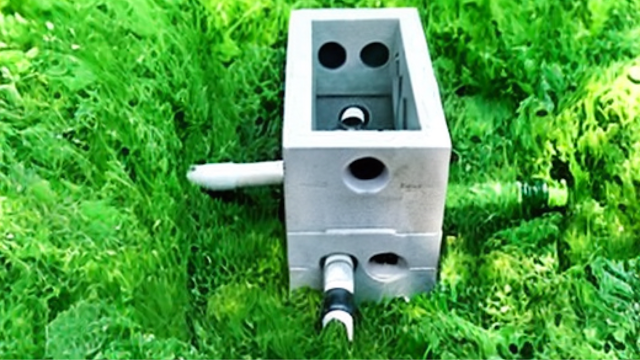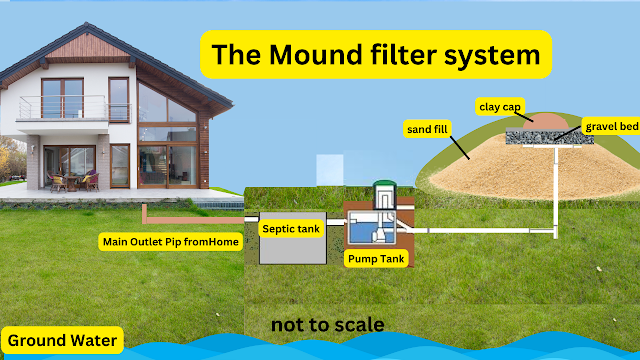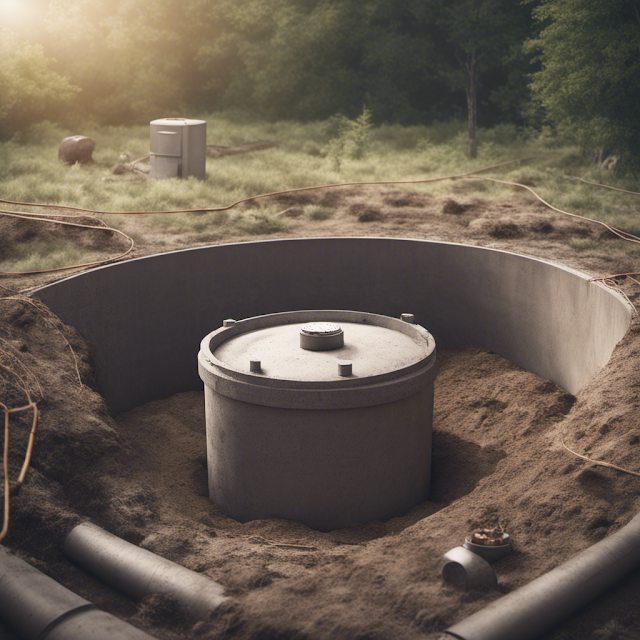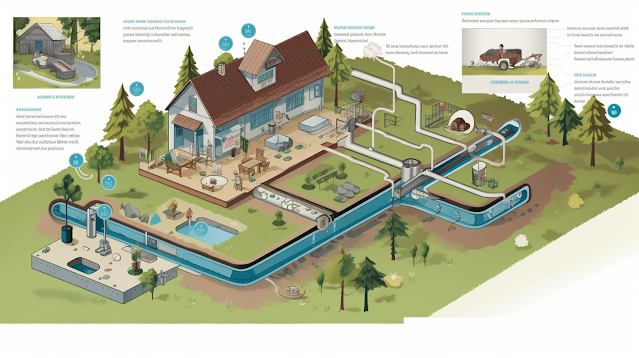Septic System Alternatives: A Better Fit for Unique Property Conditions
 |
| Septic System Alternatives |
Septic System Alternatives offer a more suitable solution for unique property conditions, where traditional septic tanks may not be feasible. These systems, designed for shallow soil, high water tables, or sensitive ecosystems, divert and clean water waste before reintroducing it back into the environment.
With varying levels of required maintenance and costs, alternative septic systems cater to properties with bedrock too close to the surface, those near sensitive bodies of water, and those with soil that won't perk.
In this article, we will explore the importance of these systems, how they work, and factors to consider when choosing the right alternative septic system for your property.
MUST SEE FAQs at end of article
Key Takeaways
- Alternative septic systems are designed to address specific property conditions such as shallow soil, high water tables, or sensitive ecosystems.
- These systems offer a better fit for properties where a conventional septic system is not feasible.
- Alternative septic systems provide different levels of required maintenance and have varying costs.
- Some common types of alternative septic systems include mound systems, pressurized dosing systems, plastic chamber leach fields, sand filters, aerobic treatment systems, drip distribution/irrigation, and constructed wetland systems.
The Importance of Alternative Septic Systems
Alternative septic systems are important because they provide a viable solution for properties with unique conditions that make a conventional septic tank impractical.
The advantages of alternative septic systems are numerous. They offer tailored solutions for properties with shallow soil, high water tables, or sensitive ecosystems. These systems allow for proper wastewater treatment and reduce the risk of water pollution.
Evaluating the environmental impact of alternative septic systems is crucial. By diverting and cleaning water waste, these systems help protect the environment and preserve water quality. Additionally, alternative septic systems can be designed to minimize the use of chemicals and energy, further reducing their environmental footprint.
Overall, these systems provide an effective and sustainable option for properties that face challenges with traditional septic tanks.
Understanding Unique Property Conditions
Shallow soil, high water tables, and environmentally sensitive ecosystems can present challenges for traditional septic tank installations. In order to address these unique property conditions, alternative septic systems have been developed. These systems offer innovative technologies that comply with alternative septic system regulations while providing effective wastewater treatment.
Here are four examples of alternative septic systems:
Mound Systems: These above-ground systems are covered in topsoil and are suitable for properties with shallow soil and high water tables. They require regular maintenance and are commonly used as an alternative to septic tanks.
Pressurized Dosing: This system uses pressure to evenly distribute effluent into the leach field. It is effective for rehabilitating a failed leach field and can be combined with water treatment systems.
Plastic Chamber Leach Field: Ideal for small lots and properties with high or variable groundwater tables, this system replaces gravel in the leach field with plastic chambers. It is compatible with environmentally sensitive areas and does not require a leach field.
Sand Filter: These systems use sand to purify wastewater and remove toxins. They are suitable for environmentally sensitive areas and can directly pass treated water into the soil without a leach field.
These alternative septic systems provide solutions for properties with unique conditions, ensuring effective wastewater treatment while complying with regulations.
How Alternative Septic Systems Work
Septic System Alternatives
Mound systems, pressurized dosing, plastic chamber leach fields, and sand filters are all examples of alternative septic systems that employ different technologies to treat wastewater effectively. These alternative septic system designs offer several advantages over conventional septic tanks.
Alternative Septic Systems and Their Advantages:
- Suitable for dense or shallow soil and high water tables.
- Treats and reintroduces effluent safely into the environment.
Pressurized Dosing
- Effective for rehabilitating a leach field after a septic system failure.
- Can be combined with other water treatment systems.
Plastic Chamber Leach Field
- Ideal for small lots and properties with high or variable groundwater tables.
- Compatible with environmentally sensitive areas.
Sand Filter
- Purifies and removes toxins from wastewater using sand.
- Can pass treated water directly to the soil without a leach field.
Aerobic Treatment System
- Stimulates bacterial activity to effectively treat wastewater.
- Suitable for properties with suboptimal soil conditions.
These alternative septic systems provide solutions for unique property conditions, such as shallow soil, high water tables, or environmentally sensitive areas. They offer various benefits, including improved wastewater treatment, compatibility with specific soil conditions, and the ability to rehabilitate failed leach fields.
By employing different technologies, these alternative septic systems ensure that wastewater is treated effectively and safely reintroduced into the environment.
Factors to Consider When Choosing an Alternative Septic System
When choosing a different type of wastewater drainage system, homeowners must consider several factors to ensure it meets their specific needs. Here are the key factors to consider when selecting an alternative septic system:
Property Conditions: Assess the soil type, water table levels, and land size to determine which system is most suitable. Different alternative systems are designed to address specific property conditions.
Maintenance Requirements: Evaluate the level of maintenance required for each system. Some systems may require more frequent inspections and servicing compared to conventional septic tanks.
Cost Comparison: Compare the costs associated with installing and maintaining different alternative septic systems. Consider the initial installation costs, ongoing maintenance expenses, and any potential repairs or replacements.
Environmental Impact: Examine the environmental impact of each system. Consider how the system treats the wastewater and its impact on the surrounding ecosystem.
Mound Systems: A Closer Look
An above-ground system covered in topsoil with a pump chamber separates effluent in mound systems. Mound systems are a common alternative to septic tanks and are suitable for properties with dense or shallow soil and high water tables. This type of alternative septic system is more expensive and requires more maintenance than conventional systems. However, it offers several advantages. The effluent is treated and safely reintroduced into the environment, reducing the risk of water pollution. Mound systems also provide a solution for properties where a conventional septic tank is not feasible due to bedrock close to the surface or flooding issues. On the other hand, the environmental impact of alternative septic systems, including mound systems, should be considered. While they can help prevent contamination of water sources, the construction and maintenance of these systems may disrupt natural habitats and require energy consumption.
Pros and Cons:
Pros:
- Effective treatment and reintroduction of effluent into the environment.
- Suitable for properties with dense or shallow soil and high water tables.
- Reduces the risk of water pollution.
- Provides a solution for properties with bedrock close to the surface or flooding issues.
Cons:
- More expensive than conventional septic systems.
- Requires more maintenance.
- Construction and maintenance may disrupt natural habitats.
- Requires energy consumption.
Pressurized Dosing Systems: An Effective Solution
Pressurized dosing systems effectively distribute effluent evenly into the leach field, making them a reliable option for properties with specific soil characteristics. Here are the advantages of pressurized dosing systems:
Efficient distribution: Pressurized dosing systems use pressure to evenly distribute effluent throughout the leach field. This ensures that all areas of the field receive an equal amount of wastewater, preventing overloading in one area and potential system failure.
Rehabilitation capability: Pressurized dosing can be combined with other water treatment systems to rehabilitate a leach field after a septic system failure. This allows for the effective restoration of the system without the need for costly replacements.
Specific soil suitability: Pressurized dosing systems are a suitable alternative for properties with specific soil conditions. They can be designed and installed to accommodate high water tables, shallow or dense soil, and other site-specific characteristics.
Installation process: The installation process of pressurized dosing systems involves the placement of a pump chamber, pressurized pipes, and control devices. The pump chamber collects and pressurizes the effluent, while the pipes distribute it evenly into the leach field. Control devices regulate the flow and pressure of the system, ensuring optimal performance.
Overall, pressurized dosing systems offer efficient and reliable wastewater distribution for properties with specific soil characteristics. Their installation process involves careful design and implementation to ensure optimal performance.
Plastic Chamber Leach Field: A Compact Alternative
The plastic chamber leach field provides a compact and efficient solution for properties with high or variable groundwater tables and small lots. The installation process of a plastic chamber leach field involves excavating a trench and placing the plastic chambers in a specific configuration. These chambers, made of durable plastic, create a void for the wastewater to flow.
The effluent from the septic tank is distributed into the chambers, allowing it to come in contact with the soil beneath. This contact with the soil helps in the treatment of the water. The installation process is relatively straightforward and can be completed in a shorter time compared to traditional leach fields.
In terms of long-term maintenance requirements, the plastic chamber leach field needs periodic inspections and pumping to remove accumulated solids. Additionally, regular monitoring of the groundwater table is necessary to ensure that the system is functioning properly.
Sand Filter Systems: Purifying Wastewater
Sand filter systems effectively purify wastewater by incorporating sand and oxygen to remove toxins and pathogens. These systems offer several advantages and environmental benefits:
Efficient filtration: The sand acts as a natural filter, trapping impurities and contaminants present in the wastewater.
Pathogen removal: Oxygenation of the wastewater helps in the breakdown of harmful pathogens, ensuring a safer effluent for disposal or reuse.
Environmentally friendly: Sand filter systems provide a sustainable solution for wastewater treatment. They do not require a leach field, reducing the impact on land usage.
Water conservation: Treated water can be safely reintroduced into the environment or reused for irrigation, contributing to water conservation efforts.
Sand filter systems are a reliable and eco-friendly alternative for properties with specific conditions or in environmentally sensitive areas. Their efficient purification process and environmental benefits make them a suitable choice for wastewater treatment.
Exploring Aerobic Treatment Systems
Aerobic treatment systems stimulate bacterial activity by incorporating oxygen into the treatment tank. This process promotes the growth of aerobic bacteria, which are more efficient in breaking down organic matter compared to anaerobic bacteria.
The benefits of aerobic treatment systems include effective wastewater treatment, especially for small lots, properties with suboptimal soil conditions, or those located near sensitive bodies of water. These systems provide a viable alternative to conventional septic systems in such situations.
However, implementing aerobic treatment systems can present certain challenges. They require more maintenance compared to conventional systems, as the oxygen supply needs to be consistently monitored and maintained. Additionally, the initial installation cost of aerobic treatment systems may be higher.
However, considering their superior treatment capabilities, these challenges can be outweighed by the long-term benefits they offer.
Drip Distribution/Irrigation Systems: Efficient Water Dispersal
After exploring the benefits of aerobic treatment systems, let's delve into another alternative septic system: the drip distribution/irrigation system. This system utilizes a method of efficient water dispersal that promotes water conservation and energy efficiency.
Water Conservation: Drip distribution/irrigation systems excel in water conservation by releasing treated septic water over a larger surface area of land. This method ensures that every drop of water is utilized effectively, reducing waste and promoting sustainable water usage.
Energy Efficiency: With newer technology, drip distribution/irrigation systems allow for timed and controlled release of water. This not only optimizes the irrigation process but also minimizes energy consumption by utilizing electricity to power the system. Though it requires maintenance due to the need for electricity, the energy efficiency benefits make it a viable choice for properties with specific irrigation needs.
Controlled Water Dispersal: Long, flexible tubing with small water increments is used to disperse the water, providing precise control over the release. This ensures that the water is distributed evenly and effectively throughout the designated area, optimizing the irrigation process.
Suitable for Unique Property Conditions: Drip distribution/irrigation systems are a suitable alternative for properties with specific irrigation needs. Whether it is a large agricultural area or a small residential property, this system can be tailored to meet the unique requirements of the property while promoting water conservation and energy efficiency.
Constructed Wetland Systems: Natural Filtration
Constructed wetland systems utilize wetland plants for natural filtration, purifying treated water before it is reintroduced into the environment. These systems offer numerous benefits, both in terms of water treatment and environmental impact. The table below highlights some of the key advantages and impacts of constructed wetland systems:
Benefits of Constructed Wetland Systems:
- Highly effective in removing pollutants.
- Cost-effective compared to traditional treatment methods.
- Requires minimal energy for operation.
- Provides natural aesthetics and recreational opportunities.
- Can be integrated into existing landscapes.
Environmental Impact of Constructed Wetland Systems:
- Enhances biodiversity by providing habitat for wildlife.
- Reduces the need for chemical additives.
- Promotes groundwater recharge.
- Improves water quality in nearby water bodies.
- Reduces the risk of nutrient runoff.
Constructed wetland systems not only provide efficient water treatment but also have a positive environmental impact by improving biodiversity, reducing chemical use, promoting water quality, and enhancing the natural aesthetics of the area.
Benefits of Alternative Septic Systems for Unique Property Conditions
After discussing the benefits of constructed wetland systems for unique property conditions, it is important to highlight the advantages and environmental benefits of alternative septic systems as a whole.
These systems offer numerous benefits for properties that cannot accommodate conventional septic tanks. Here are some key advantages and environmental benefits of alternative septic systems:
Improved wastewater treatment: Alternative septic systems utilize advanced technologies to effectively treat wastewater, ensuring cleaner water is reintroduced into the environment.
Customized solutions: These systems can be tailored to specific property conditions such as shallow soil, high water tables, or sensitive ecosystems, providing a better fit and minimizing the risk of water pollution.
Reduced impact on natural resources: Alternative septic systems promote sustainable water usage by efficiently managing and reusing water waste, reducing the strain on local water sources.
Long-term cost savings: While alternative septic systems may have higher upfront costs, they often require less maintenance over time, resulting in long-term cost savings for property owners.
Overall, alternative septic systems offer a range of advantages and environmental benefits, making them a valuable solution for unique property conditions.
Cost Considerations for Alternative Septic Systems
The cost considerations for alternative septic systems vary depending on factors such as system type, installation requirements, and ongoing maintenance needs. When evaluating the cost effectiveness of alternative septic systems, it is important to consider the initial installation expenses as well as the long-term maintenance costs.
Alternative septic systems, such as mound systems or sand filters, can be more expensive to install compared to conventional septic tanks. Additionally, these systems may require more frequent monitoring and servicing, resulting in higher maintenance costs over time.
It is also important to consider the disadvantages of alternative septic systems, such as the need for electricity in systems like drip distribution or the potential for clogging in sand filters.
Overall, while alternative septic systems can provide solutions for unique property conditions, it is crucial to carefully assess their cost effectiveness and maintenance requirements before making a decision.
Maintenance Requirements for Alternative Septic Systems
Pressurized dosing systems require regular monitoring and servicing to ensure efficient distribution of effluent into the leach field. Here are the maintenance requirements for alternative septic systems:
Regular Inspections: It is important to conduct routine inspections of the pressurized dosing system to check for any leaks or blockages. This ensures that the effluent is evenly distributed and prevents any potential system failures.
Pump Maintenance: The pump chamber in the pressurized dosing system should be inspected and serviced regularly. This includes checking the pump operation, cleaning the pump, and replacing any worn-out parts to maintain optimal performance.
Filter Cleaning: The filters in the pressurized dosing system should be cleaned periodically to prevent clogs and ensure proper flow of effluent. This can be done by removing the filters and washing them with water or using a specialized cleaning solution.
Alarm System Check: Pressurized dosing systems are equipped with an alarm system that alerts homeowners about any malfunctions or high liquid levels. It is important to regularly test and maintain the alarm system to ensure it functions properly.
Overall, regular maintenance of pressurized dosing systems is crucial for the successful installation and operation of alternative septic systems. By following these maintenance requirements, homeowners can enjoy the advantages of alternative septic systems, such as improved wastewater treatment and better suitability for unique property conditions.
Choosing the Right Alternative Septic System for Your Property
When choosing the right alternative septic system for your property, there are several factors to consider.
Firstly, you need to assess the specific conditions of your property, such as soil type, water table level, and proximity to sensitive ecosystems. This will help determine which alternative septic system is most suitable.
Secondly, you should consider the installation process and whether it aligns with your property's characteristics. Some systems, like mound systems and plastic chamber leach fields, require above-ground installation, while others, like sand filters and aerobic treatment systems, can be installed above or below ground.
Additionally, the cost and required maintenance of each system should be taken into account.
Frequently Asked Questions
Are There Any Financial Incentives or Tax Benefits Available for Installing Alternative Septic Systems?
Yes, there are financial incentives and tax benefits available for installing alternative septic systems in the United States. These incentives vary from state to state, but some common examples include:
- Loans and grants: Many states offer low-interest loans or grants to help homeowners finance the installation of an alternative septic system.
- Tax credits: Some states offer tax credits to homeowners who install alternative septic systems.
- Property tax exemptions: Some states exempt alternative septic systems from property taxes.
- Utility rebates: Some utilities offer rebates to homeowners who install alternative septic systems that help to reduce water pollution.
To find out about the financial incentives and tax benefits available in your state, you can contact your state's environmental protection agency or your local health department.
Here are some specific examples of financial incentives for alternative septic systems in different states:
- *Delaware: The Delaware Individual Household Well & Septic Loan Program offers loans of up to $15,000 to residents of rural communities to pay for the installation of a new standard or alternative septic system. The interest rate is locked in at 1 percent.
- Florida: The Florida Department of Environmental Protection offers a Wastewater Grant Program (WWGP) that provides funding for the installation of alternative septic systems in areas with impaired water quality. Grants are available for up to 75% of the total project cost.
- Connecticut: The Connecticut Rural Transit (CRT) offers low-interest loans to private citizens for the repair, replacement, or enlargement of septic systems. Loans are available for up to $25,000 and the interest rate is 4%.
If you are considering installing an alternative septic system, it is important to do your research to find out about the financial incentives and tax benefits available in your state. This could help to make the installation more affordable and worthwhile. *US EPA
Can Alternative Septic Systems Be Installed in Areas With Strict Environmental Regulations?
Yes, alternative septic systems can be installed in areas with strict environmental regulations in the USA. In fact, many of these regulations specifically encourage the use of alternative septic systems because they are more environmentally friendly than traditional septic systems.
Some of the factors that are considered when determining whether an alternative septic system can be installed in a particular area include:
- The soil type
- The depth of the water table
- The amount of rainfall
- The proximity to surface water
- The size of the home
- The number of people living in the home
- The amount of wastewater generated
There are a variety of alternative septic systems available, each with its own advantages and disadvantages. Some of the most common alternative septic systems include:
- Infiltration systems: These systems use trenches or beds of sand or gravel to filter wastewater into the ground.
- Aerobic systems: These systems use bacteria to break down wastewater in an oxygenated environment.
- Vegetative systems: These systems use plants to help filter wastewater.
- Microbial fuel cells: These systems use electricity generated by bacteria to break down wastewater.
The best alternative septic system for a particular property will depend on the specific conditions of the property and the needs of the homeowners. It is important to consult with a qualified septic installer to determine which system is right for you.
Here are some of the benefits of using alternative septic systems:
- They are more environmentally friendly than traditional septic systems.
- They can be installed in areas where traditional septic systems cannot be installed.
- They can be more reliable and require less maintenance than traditional septic systems.
- They can be more affordable than traditional septic systems in the long run.
If you are considering installing an alternative septic system, it is important to do your research to find out which system is right for you. You should also contact your local health department or environmental protection agency to find out about the regulations that apply in your area.
What Are the Long-Term Maintenance Costs Associated With Alternative Septic Systems?
Are There Any Limitations or Restrictions on the Use of Water-Intensive Appliances or Fixtures With Alternative Septic Systems?
Yes, there are some limitations or restrictions on the use of water-intensive appliances or fixtures with alternative septic systems. These limitations vary depending on the type of system and the specific regulations in your area.
Some common limitations include:
- Limiting the number of times a toilet is flushed per day.
- Not using a garbage disposal.
- Not using a dishwasher.
- Limiting the amount of water used for bathing or showering.
- Not using a pool or hot tub.
It is important to check with your local health department or environmental protection agency to find out the specific limitations that apply to your area.
Here are some tips for using water-intensive appliances and fixtures without overloading your alternative septic system:
- Flush the toilet less often. Instead of flushing every time you use the toilet, try to wait until you have a full load. You can also try using a toilet that has a dual flush feature, which allows you to flush with less water for liquid waste.
- Don't use a garbage disposal. Garbage disposals can add a lot of solids to your septic system, which can overload it. Instead, compost your food scraps or throw them away in the trash.
- Use a dishwasher. Dishwashers are more efficient than washing dishes by hand, so they are a good option for reducing water use. However, make sure to choose a dishwasher with an Energy Star label, which means it is more efficient than other models.
- Take shorter showers. Showers are a major source of water use in the home. Try to take shorter showers and conserve water by turning off the water when you are soaping up or shampooing your hair.
- Don't use a pool or hot tub. Pools and hot tubs can add a lot of water to your septic system, so it is best to avoid them if possible. If you do have a pool or hot tub, make sure to drain it regularly and clean it properly to prevent the buildup of bacteria.



.png)






Comments
Post a Comment